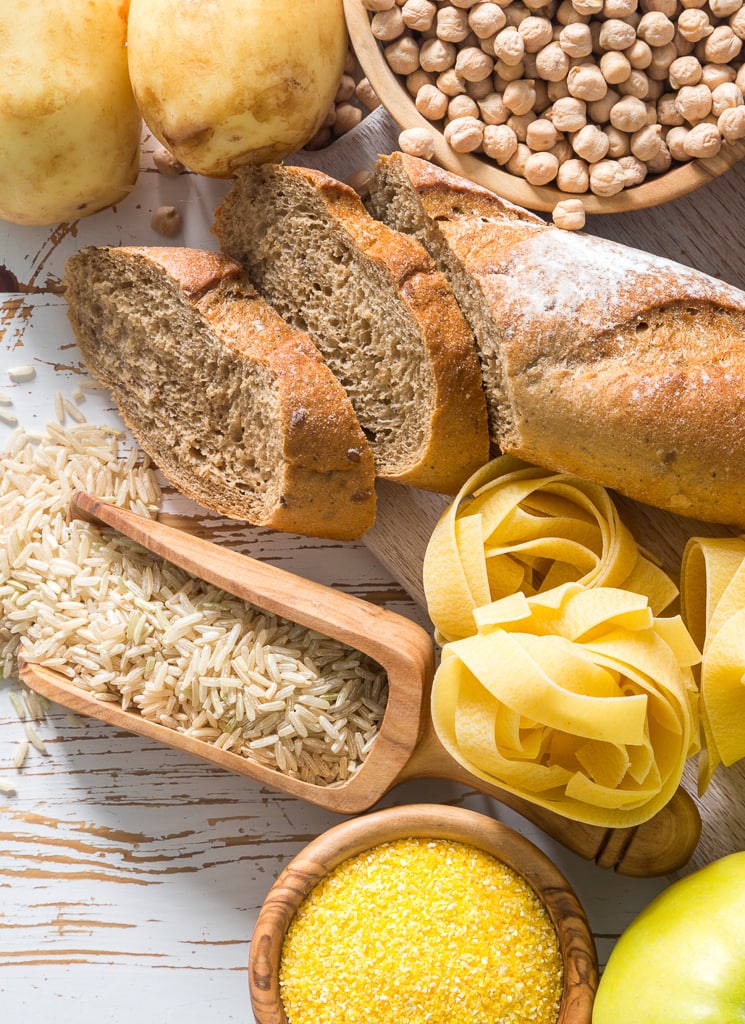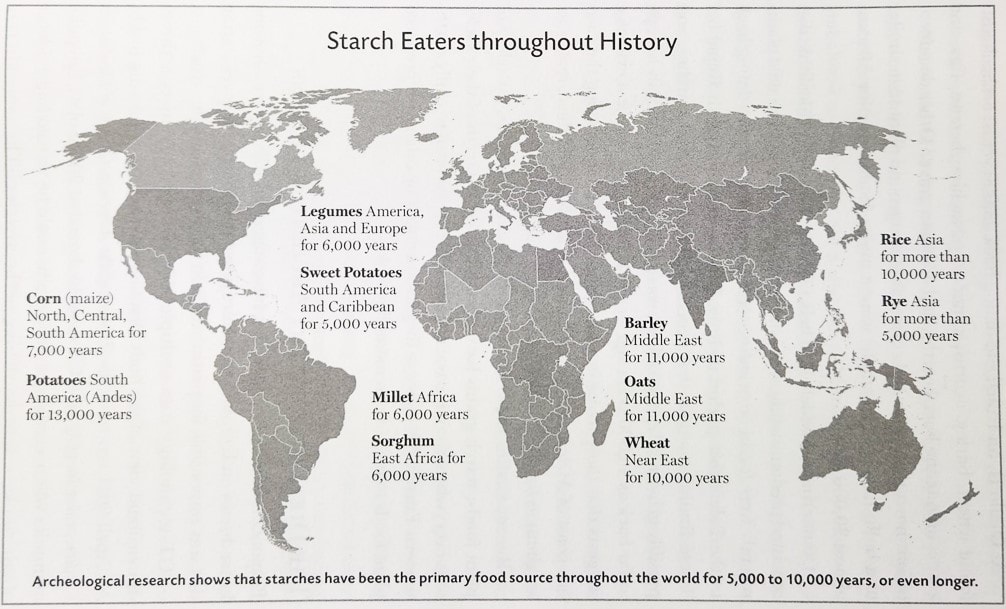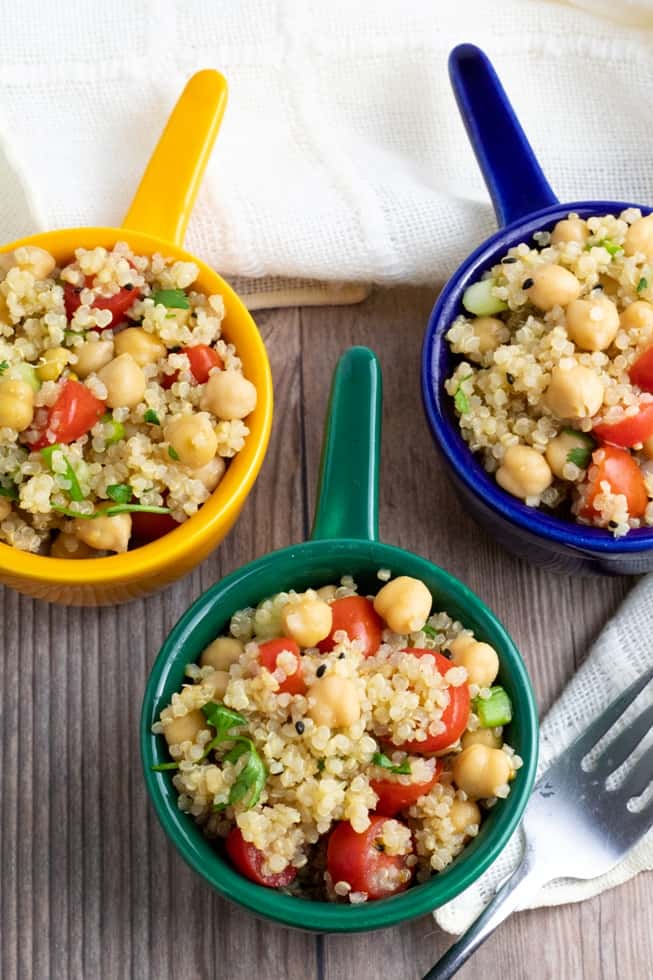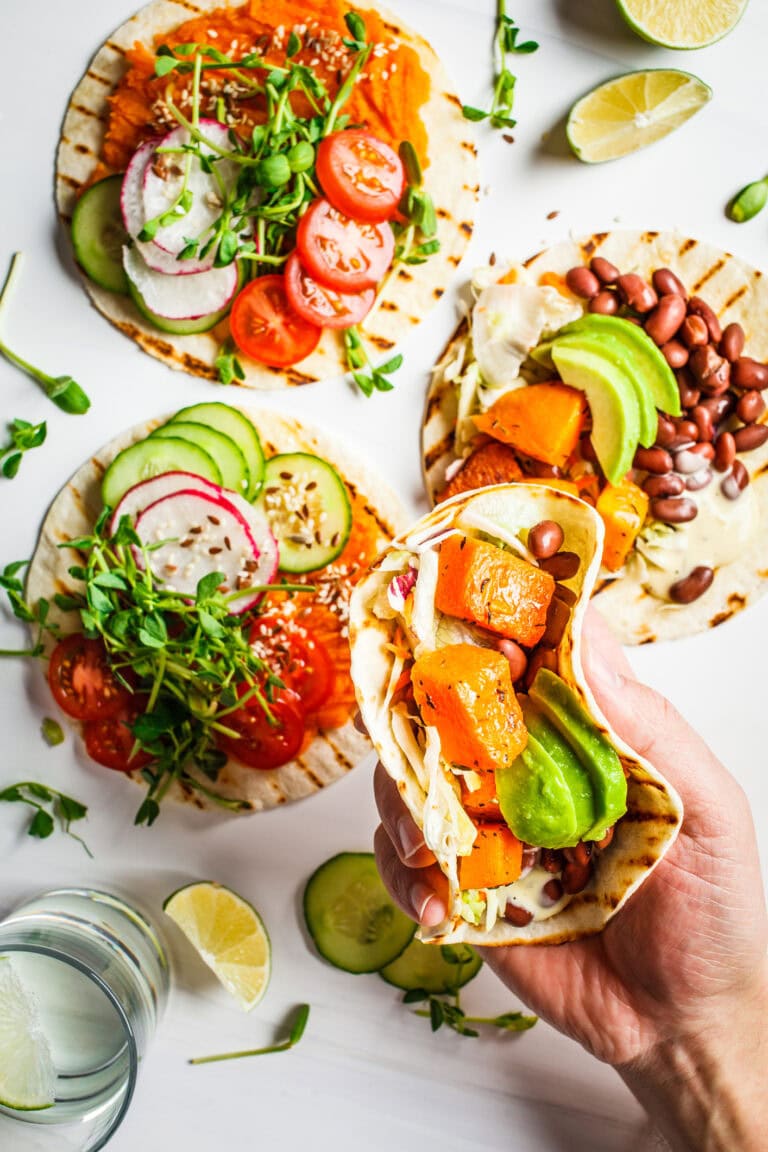Dr. McDougall | Do Carbs Make You Fat?
Internationally recognized physician and author, Dr. John McDougall, MD says, “The fat you eat is the fat you wear.” So where is the fat coming from? Contrary to popular belief, research shows that it’s not carbs.

The Real Paleolithic Diet
Look at a globe–any region with a large population of trim, healthy people reveals the same truth: Healthy populations get most of their calories from starch. Eat a traditional meal in Japan, China, or almost any Asian country and you will find your bowl filled with rice, possibly alongside sweet potatoes and buckwheat.
The same truth dates back throughout recorded human history. The Incas of South America centered their diet on potatoes. The Incan warriors switched to quinoa for strength prior to battle. The Mayans and Aztecs of Central America were known as “the people of the corn.” The ancient Egyptians’ starch of choice was wheat.

Throughout civilization and around the world, six foods have provided our primary fuel: barley, corn, millet, potatoes, rice, and wheat.
If the map hasn’t convinced you, science documents it well: Over at least the past 13,000 years, starch has been central to the diets of all healthy, large, successful populations. In fact, new discoveries show evidence of starch-based diets even earlier.
At Ohalo II, an Israeli site dating back 23,000 years, archeologists found wheat, barley, acorns, almonds, pistachios, berries, figs, and grapes among the huts, hearths, and a human grave.1 Other documentation shows that bulbs and corms (an underground plant stem similar to a bulb; taro is an example) were a major food source for Africans almost 30,000 years ago.2
Countering the widely held belief that the European Paleolithic diet consisted predominantly of animal foods, starch grains from wild plants recently were found on grinding tools at archeological sites dating back to the Paleolithic period in Italy, Russia, and the Czech Republic.

These findings suggest that processing vegetables and starches, and possibly grinding them into flour, was a widespread practice in Europe as far back as 30,000 years ago, or even earlier.3
Other recent evidence suggests that those living in what is now Mozambique, along the eastern coast of Africa, may have followed a diet based on the cereal grass sorghum as long as 105,000 years ago.4
The Warrior’s Diet
Throughout history, men and women who ate diets based on grains, vegetables, and fruits have accomplished history’s greatest feats. The ancient conquerors of Europe and Asia, including the armies of Alexander the Great (356-323 BC) and Genghis Khan (AD 1162-1227), who conquered the known Western worlds during their respective times, consumed diets based on starches. Caesar’s legions complained when they had too much meat in their diet and preferred to do their fighting on grains.5

The remains of 60 Roman gladiators who fought and died more than 1,800 years ago in Ephesus, in western Turkey, were recently found in a 200-square-foot plot along the road that led from the city center to the Temple of Artemis.6 Analysis of their bones for calcium, strontium, and zinc showed that the world’s fiercest fighters followed an essentially vegan diet.
In contemporary accounts, the gladiators are sometimes referred to as hordearii, or barley men, since barley provided the bulk of the nutrients that gave their remarkably strong muscles and bones the strength and endurance to compete in the ultimate sport of life and death.
Reclaiming Starch
With the exception of wealthy aristocrats, humans throughout history have derived most of their energy from starch. Life began to change with the colossal wealth created during the Industrial Revolution of the mid-1800s.
As we began to successfully harness fossil fuels, millions and then billions of people began to eat from tables heaped high with meat, fowl, and dairy–foods that previously were eaten only by royalty. You can easily see the result: We’ve inflated to resemble the rotund images of aristocrats.
When we consume too much fat, the body looks for a place to store it, typically in the belly, buttocks, and thighs. The fat you eat is the fat you wear, quite literally.
Starches provide energy and an abundance of nutrients without being stored visibly as fat. Quite the opposite: They fuel us with the proteins, essential fats, vitamins, and minerals that make our bodies run like the efficient machines they were meant to be.
Starches are a clean-burning fuel, with just a small fraction (1 to 8 percent) of their calories coming from fat. They have insignificant amounts of cholesterol. Unless they have come into contact with them from animal waste or tissue, they do not harbor pathogens like salmonella, E. coli, or mad cow prions (agents causing bovine spongiform encephalopathy).
They don’t store up poisonous chemicals from the environment like DDT or methyl mercury. Unless they become contaminated by pesticides directly introduced by farmers, starches are squeaky clean.
Some starches, like potatoes and sweet potatoes, are complete foods. By eating these foods alone you will easily meet your basic nutritional needs with the exception of vitamin B12.
Grains and legumes aren’t quite as complete as potatoes, but add a small dose of vitamin A and C by eating a little fruit or green and yellow vegetables and you’ve got everything you need. No animal protein or dairy needs to be added for excellent and complete nutrition.
Starches aren’t just good for you, they’re also satisfying. The abundant carbohydrates in starches stimulate the sweet taste receptors on the tip of the tongue, where gastronomic pleasure beings.
Eat enough starches and your body will release hormones and go through neurological changes that ensure long-term satisfaction. Their naturally great taste and nourishing calories and the good feeling they give us during and after eating them are the reason we refer to bread, rice, pasta, potatoes, corn, and beans as “comfort foods.”
It is well accepted that starches are a great source of abundant calories, providing the energy athletes need to do everything from discus throwing to extreme skateboarding to running marathons.
With all those efficient calories, you would think that starches would promote excess weight gain, but they don’t. That’s because your body efficiently regulates the use of the carbohydrates you get from starch: Even if you consume them in excess, the body will burn them off as heat and energy rather than store much of them as fat.7
The Truth is Well Known
Despite the drone from big business seeking to deafen our ears to it, sound advice to eat more vegetables, fruits, and whole grains–and less fat from meat and dairy products–has been given since the 1950s.
In the introduction to a 1977 report from the US Senate Select Committee on Nutrition and Human Needs, Dr. D. Mark Hegsted of the Harvard School of Public Health wrote, “I wish to stress that there is a great deal of evidence and it continues to accumulate, which strongly implicates and, in some instances, proves that the major causes of death and disability in the United States are related to the diet we eat. I include coronary artery disease, which accounts for nearly half of the deaths in the United States, several of the most important forms of cancer, hypertension, diabetes, and obesity as well as other chronic diseases.”8
In 2002, the World Health Organization published a report explaining that the shift toward refined foods, foods of animal origin (meat and dairy products), and increased fats was behind the global epidemics of obesity, diabetes, and cardiovascular disease.
The report predicted that by 2020, two-thirds of the global burden of disease will be attributable “to chronic noncommunicable disease, most of them strongly associated with diet.”9
Our unwillingness to respond to this vast base of knowledge, from ancient to modern, has resulted in the greatest health crisis known to humankind. Worldwide, 1.1 billion people are overweight and 312 million obese, 18 million die of heart disease annually, more than 197 million have diabetes, and half of all people following a Western diet will develop life-threatening cancers.10
It’s not just individuals who are suffering. Alongside escalating human sickness, we are experiencing environmental catastrophes that are due in large part to abandoning a diet based on starches in favor of putting meat at the center of the plate. Livestock are among the top two or three contributors to every one of our most serious environmental problems, including climate change.11

Eating a starch-based diet can help you to lose weight and feel and look better, and–with no extra effort–help to heal the world around you, reducing global warming and making our planet healthier and more sustainable for future generations. The only way to find out if a starch-based diet holds all these promises for you is to give it a try.
This article is an excerpt from The Starch Solution by guest author, Dr. John McDougall, MD.
This post may contain affiliate links. Read my full disclosure here.
About the author

Dr. John McDougall’s national recognition as a nutrition expert earned him a position in the Great Nutrition Debate 2000 presented by the USDA. He is a board-certified internist, author of 13 national best-selling books, and co-founder of the McDougall Program. He has dedicated over 50 years of his life caring for people with diet and lifestyle medicine. Dr. McDougall has developed a nourishing, low-fat, starch-based diet that not only promotes a broad range of dramatic and lasting health benefits such as weight (fat) loss but most importantly can also reverse serious illnesses, such as heart disease, without drugs.
He has cared for thousands of patients over almost three decades of medical practice and has run a highly successful live-in program for more than 17 years.
Dr. McDougall’s website has all the information you need to start eating more healthfully. The information is provided for the benefit of all and includes a free program, free lectures, and free newsletters containing a wealth of information.
For those of you new to the whole food plant-based lifestyle, we’ve created a FREE 7-Day Plant-Based Menu Planner to help you get started!
Books by Dr. McDougall
- The Starch Solution
- The Healthiest Diet on the Planet
- The McDougall Plan: 12 Days to Dynamic Health
- McDougall’s Medicine: A Challenging Second Opinion
- The McDougall Program for Maximum Weight Loss
- The New McDougall Cookbook
- The McDougall Program for Women
- The McDougall Program for a Healthy Heart
Scientific articles on a healthy diet
- Vegan Sources of Calcium
- How Not to Die by Dr. Michael Greger: The Intro
- A Physician’s Perspective on COVID-19, Inflammation, & Nutrition
- Protein: The Building Block of Life
- How to Start a Plant-Based Diet: Fast Way vs Slow Way
- Healthiest Foods to Eat Daily
- Top Plant-Based Doctors and Experts
- Diet for Heart Health and More
Citations
- Weiss E, Wetterstrom W, Nadel D, Bar-Yosef O. The broad spectrum revisited: evidence from plant remains. Proc Natl Acad Sci USA. 2004 Jun 29; 101 (26): 9551:55.
- Deacon HJ. Planting an idea: An archeology of stone age gatherings in South Africa. S. Afr Archaeol Bull 48: 86-93, 1993.
- Revedin A, Aranguren B, Becattini R, Longo L, Marconi E, Lippi MM, Skakun N, Sinitsyn A, Spiridonova E, Svoboda J. Thirty thousand-year-old evidence of plant food processing. Proc Natl Acad Sci USA. 2010 Nov 2; 107 (44): 18815-19.
- Mercader J. Mozambican grass seed consumption during the Middle Stone Age. Science. 2009 Dec 18; 326 (5960): 1680-83.
- Durant W. The Story of Civilization Vol III: Caesar and Christ. (New York: Simon and Schuster, 1944).
- Curry A. The gladiator’s diet. Archeology 2008 Nov/Dec 61. www.archaeolgy.org/0811/abstracts/gradiator.html.
- Flatt JP. Carbohydrate balance and body-weight regulation. Proc Nutr Soc. 1996 Mar; 55 (1B): 449-65.
- Zerodisease.com/archive/Dietary_Goals_For_The_United_States.pdf
- Chopra M, Galbraith S, Darnton-Hill I. A global response to a global problem: the epidemic of overnutrition. Bull World Health Organ. 2003 Jan 23; 80:952-58.
- Hossain P, Kawar B, El Nahas M. Obesity and diabetes in the developing world-a growing challenge. N. Engl J Med. 207 Jan 18; 356 (3): 213-15.
- www.fao.org/docrep/010/a0701e00.htm






Wow! What a fantastic and informative article! I LOVE potatoes so this is great news to me. I have also been incorporating corn into my diet for sugar intake, so it’s great to know it is that much more valuable. So great! Thanks to Dr. John McDouggal for a great read. Much love!
Hey there Lexi! Dr. McDougall is one of my favs. Girl, you know I love potatoes too–any way you can make ’em! 🙂